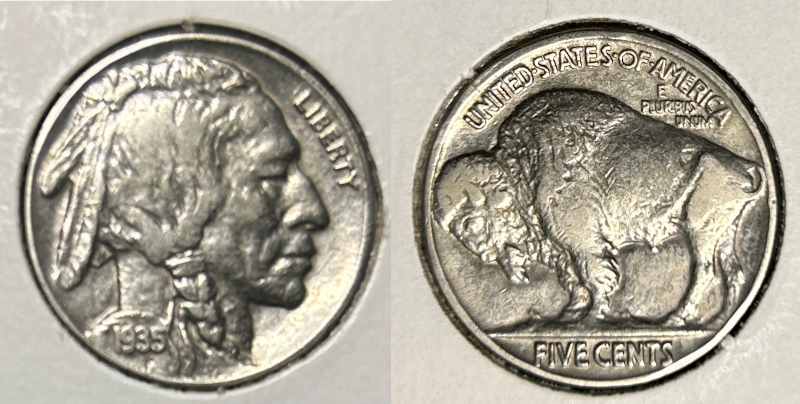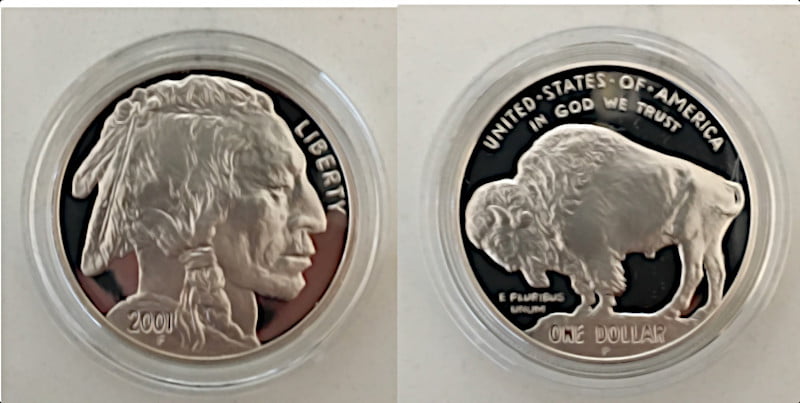One thing I’ve learned through my years of coin collecting is that truly popular designs never really go away – politicians and Treasury officials will always figure out ways to recycle them.
For instance, in 1986 the U.S. Mint resurrected two of the most universally beloved and acclaimed coin designs, the Walking Liberty half dollar and the Saint Gaudens double eagle, for its silver and gold eagles, respectively. Three decades later, the Mint re-used the Mercury dime obverse for its palladium eagles. After all, why waste perfectly good (and popular) designs. Especially if they help entice investors, collectors and doomsday preppers to part with their hard-earned money.
So, when the government was coming up with ways to fund the Smithsonian National Museum of the American Indian in 2000, one of the things it did was authorize a special commemorative silver dollar featuring one of the most iconic designs in American coinage history.
Minted from 1913 to 1938, the Buffalo nickel remains one of the most recognized and collected U.S. coins – in no small part because of its design. With a portrait of an American Indian on the obverse and an American buffalo on the reverse, perhaps no coin better represents this country’s heritage than this five-cent piece.
Additionally, Buffalo nickels tend to be fairly affordable, making them a great option for collectors, especially beginners or those on a budget. With no precious metals used in the striking process, nickels tend to be much cheaper than the silver dimes and quarters from that same era. With Buffalo nickel, collectors know that they have a reasonable shot at getting a complete set. That’s because, while there are valuable Buffalo nickels out there (most notably, error coins like the 1916 doubled-die obverse, the 1918/7-D overdate and the 1936-D three-legged buffalo reverse), there’s nothing that approaches the mythical 1913 Liberty Head nickel (only five are known to exist and one recently fetched $3.7 million at an auction in 2010).
The Buffalo nickel had at least one pretty powerful fan. Ben Nighthorse Campbell, the first Native-American elected to the Senate, loved the Buffalo nickel and what it represented so much that he tried, for many years, to resurrect it. In May 1995, two months after a controversial party switch from Democrat to Republican that remains confounding to this day, he proposed re-issuing the Buffalo nickel to commemorate Native American history and culture.

After that bill died, Campbell tried again in 1997 with no luck. In 1999, he switched tracks, unsuccessfully sponsoring a bill to use the design as the basis for a commemorative half dollar.
Finally, in 2000, he hit paydirt. Along with Representative Frank Lucas (R-OK), Campbell sponsored the American Buffalo Coin Commemorative Coin Act of 2000 (Public Law 106-375), authorizing the issuance of a commemorative silver dollar based on the Buffalo nickel design in order to raise funds for the Smithsonian American Indian museum.
This coin was in general circulation from 1913 to 1938, which is a very short time-frame, only 25 years, but it is still one of the most recognizable coins in American history. Now, nearly 60 years after the mint ceased production of the Indian head nickel, I would like this generation of Americans to reacquaint themselves to this unique piece of American heritage… The artist who designed the coin over 80 years ago is James Earle Fraser. He wanted to produce a coin that was truly American, according to his original writings, that cannot be confused with the currency of any other country. There is no more significant motif, I suppose, than the American bison, the only animal in this country not found in any other place in the world.
Senator Campbell, Congressional Record, May 18, 1995
While Campbell’s views about the coin are fairly consistent with contemporary historical and numismatic circles, they were once a distinctly minority view. Like many coins, the Buffalo nickel was highly controversial at the time and critics treated it as viciously as an Adam Sandler comedy. Most coins had some representation of Lady Liberty or an eagle on them and many numismatists criticized the nickel for its radical departure from convention. “The new ‘nickel’ is a striking example of what a coin intended for wide circulation should not be … [it] is not pleasing to look at when new and shiny, and will be an abomination when old and dull,” The New York Times argued in an editorial. Meanwhile, in a March 1913 editorial, The Numismatist stated its preference for Miss Columbia and “regret[ted] that she does not appear on the new five-cent piece” before opining, presciently, that “[w]e have no doubt that the original enlarged model of this design was of a handsome character.”
Generally, I dislike modern commemorative coins. I find the design quality on most to be poor and inferior compared to some of the classic designs of the pre-1982 commemoratives. Plus, I especially hate some of the more gimmicky coins, like colorized coins (I think they look like miniature versions of those Bradford Exchange collector’s plates they used to advertise on TV in the 80s and 90s – like this one for “Gone With the Wind” that TBS seemed to play during every commercial break – especially during Braves games or WCW Saturday Night), or curved coins, like the 2014 Baseball Hall of Fame or the 2019 Apollo 11 moon landing commemoratives.
But when I saw this Buffalo dollar, I had to have it. The Numismatist was right. The original Buffalo nickel design really does look handsome when enlarged. Additionally, each coin was triple struck with a heavier press than usual. As such, this coin really looks fantastic and catches the eye more readily than the original Buffalo nickel.

Evidently, the coin buying public agreed. The Buffalo dollar was a smash hit and sold out within weeks of its release, raising nearly $5 million for the museum. In fact, the coin was such a rousing success that Campbell tried, one more time, to resurrect the Buffalo nickel. In 2004, he and Senate colleague Mike Enzi (R-WY) introduced the Bison Nickel Restoration Act of 2004 to celebrate the animal’s recovery from the brink of extinction. The bill was referred to committee, where it died.
One year later, with Campbell no longer in the Senate, his former colleagues passed the Presidential $1 Coin Act of 2005, which, among other things, provided for the American Buffalo, a 24-karat gold bullion coin using the same Buffalo nickel design. Like its silver counterpart, the gold Buffalo is quite beautiful and aesthetically pleasing. If only they weren’t so damn expensive…
All of this makes me wonder why the Mint didn’t resurrect another popular design for its platinum eagles the way it did for the gold, silver and palladium ones. The standing liberty design used in quarters from 1916 to 1930 could have been a good fit, as would the Peace or Morgan dollar designs. Then again, dealers already seem like they’re overwhelmed with Peace and Morgan dollars. Adding more to the mountain just seems cruel.

